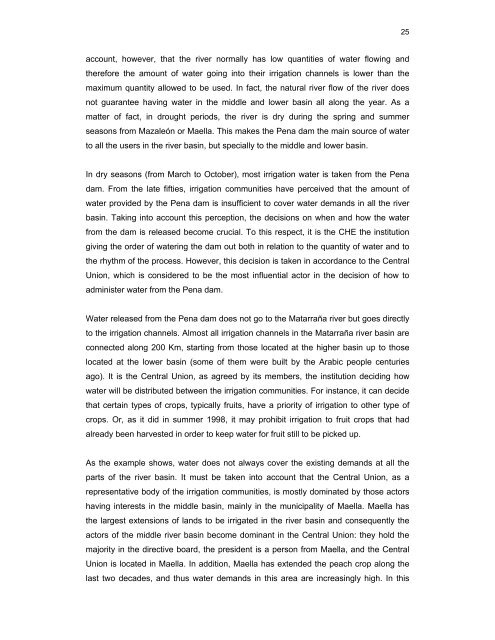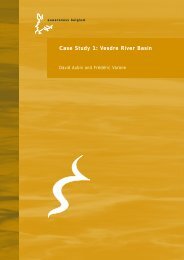Case Study 1: Matarraña River Basin - Euwareness
Case Study 1: Matarraña River Basin - Euwareness
Case Study 1: Matarraña River Basin - Euwareness
You also want an ePaper? Increase the reach of your titles
YUMPU automatically turns print PDFs into web optimized ePapers that Google loves.
account, however, that the river normally has low quantities of water flowing and<br />
therefore the amount of water going into their irrigation channels is lower than the<br />
maximum quantity allowed to be used. In fact, the natural river flow of the river does<br />
not guarantee having water in the middle and lower basin all along the year. As a<br />
matter of fact, in drought periods, the river is dry during the spring and summer<br />
seasons from Mazaleón or Maella. This makes the Pena dam the main source of water<br />
to all the users in the river basin, but specially to the middle and lower basin.<br />
In dry seasons (from March to October), most irrigation water is taken from the Pena<br />
dam. From the late fifties, irrigation communities have perceived that the amount of<br />
water provided by the Pena dam is insufficient to cover water demands in all the river<br />
basin. Taking into account this perception, the decisions on when and how the water<br />
from the dam is released become crucial. To this respect, it is the CHE the institution<br />
giving the order of watering the dam out both in relation to the quantity of water and to<br />
the rhythm of the process. However, this decision is taken in accordance to the Central<br />
Union, which is considered to be the most influential actor in the decision of how to<br />
administer water from the Pena dam.<br />
Water released from the Pena dam does not go to the <strong>Matarraña</strong> river but goes directly<br />
to the irrigation channels. Almost all irrigation channels in the <strong>Matarraña</strong> river basin are<br />
connected along 200 Km, starting from those located at the higher basin up to those<br />
located at the lower basin (some of them were built by the Arabic people centuries<br />
ago). It is the Central Union, as agreed by its members, the institution deciding how<br />
water will be distributed between the irrigation communities. For instance, it can decide<br />
that certain types of crops, typically fruits, have a priority of irrigation to other type of<br />
crops. Or, as it did in summer 1998, it may prohibit irrigation to fruit crops that had<br />
already been harvested in order to keep water for fruit still to be picked up.<br />
As the example shows, water does not always cover the existing demands at all the<br />
parts of the river basin. It must be taken into account that the Central Union, as a<br />
representative body of the irrigation communities, is mostly dominated by those actors<br />
having interests in the middle basin, mainly in the municipality of Maella. Maella has<br />
the largest extensions of lands to be irrigated in the river basin and consequently the<br />
actors of the middle river basin become dominant in the Central Union: they hold the<br />
majority in the directive board, the president is a person from Maella, and the Central<br />
Union is located in Maella. In addition, Maella has extended the peach crop along the<br />
last two decades, and thus water demands in this area are increasingly high. In this<br />
25



